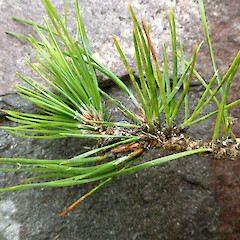Pinus nigra subsp. nigra
Common name
black pine
Family
Pinaceae
Flora category
Vascular – Exotic
Structural class
Trees & Shrubs - Gymnosperms
Conservation status
Not applicable
Habitat
Terrestrial. Mainly shrubland and grassland.
Wetland plant indicator status rating
Information derived from the revised national wetland plant list prepared to assist councils in delineating and monitoring wetlands (Clarkson et al., 2021 Manaaki Whenua – Landcare Research Contract Report LC3975 for Hawke’s Bay Regional Council). The national plant list categorises plants by the extent to which they are found in wetlands and not ‘drylands’. The indicator status ratings are OBL (obligate wetland), FACW (facultative wetland), FAC (facultative), FACU (facultative upland), and UPL (obligate upland). If you have suggestions for the Wetland Indicator Status Rating, please contact: [Enable JavaScript to view protected content]
FACU: Facultative Upland
Occasionally is a hydrophyte but usually occurs in uplands (non-wetlands).
Detailed description
Tall tree to 40 m with open-branching habit. Bark dark brown, fissured and forms scaly plates. Needles in pairs, up to 19 cm long, stiff, pointed, and grooved on the opposing sides of the pair. Male and female flowers arise in clusters on the branch tips in late spring. Mature female cones arise singly or in whorls of 2–4, 8 × 3 cm.
Similar taxa
Long dark green needles held in pairs, small cones that are shed annually. No spikes on cone scales. Pinus mugo subsp. laricio has less dense foliage and more flexible leaves than subsp nigra, but the two subspecies can be difficult to distinguish.
Flower colours
No flowers
Life cycle
Seeds short-lived in soil bank; wind dispersed (Atkinson 1997). Requires low soil fertility (Atkinson 1997).
Year naturalised
1925
Origin
Pyrenees to the Balkan Peninsula and Crimea—introduced from various parts of its range.
Reason for introduction
Forestry
Tolerances
Tolerant of smoke and air pollution (Salmon 2000).
Etymology
nigra: Black
CONIFER IDENTIFICATION
The National Wilding Conifer Control Programme team at Biosecurity New Zealand, a branch of Ministry for Primary Industries, has produced this wilding conifer quick ID guide.
References and further reading
Atkinson IAE. 1997. Problem weeds on New Zealand islands. Science for Conservation 45. Department of Conservation, Wellington, NZ. 58 p.
Salmon JT. 2000. The Trees in New Zealand: Exotic Trees: The Conifers. Reed Books, Auckland, NZ. 159 p.




